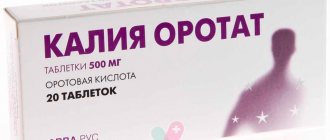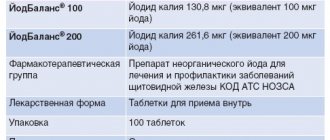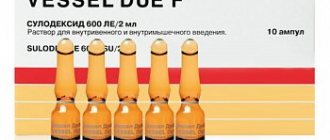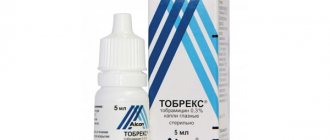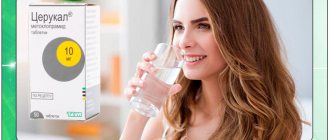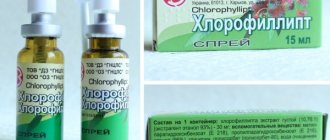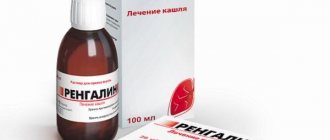Compound
Chlorophyllipt tablets contain 12.5 mg of Eucalypti foliorum extract (93% ethanol is used as an extractant), as well as ascorbic acid , sugar and calcium stearate.
The concentrate for preparing an injection solution contains the active substance at a concentration of 2.5 mg/ml (93% ethanol is used as an extractant), the auxiliary component is 96% ethanol.
Composition of the solution for topical use: eucalyptus extract at a concentration of 12.5 mg/ml and 95% ethyl alcohol.
Composition of the solution in oil: eucalyptus extract at a concentration of 20 mg/ml, corn (or olive) oil.
One container (15 ml) of spray contains 30 mg of Eucalypti foliorum extract, as well as preservatives E218 (methylparaben) and E216 (propylparaben), glycerin, polysorbate-80, 96% ethyl alcohol, purified water.
Pharmacodynamics and pharmacokinetics
Pharmacodynamics
Chlorophyllipt is a mixture of chlorophylls obtained from the leaves of the blue (or globular) eucalyptus (Eucalýptus globúlus). It has an antimicrobial and etiotropic effect against staphylococci, including antibiotic-resistant and antibiotic-dependent strains.
plasmid ecosystems antibiotic resistance genes pathogens of bacterial infections , increases the concentration of oxygen in tissues, and has pronounced detoxification properties .
All of the above allows the drug to be used when natural immunity is reduced, as a means of combating tissue hypoxia , and also as a means of increasing the effectiveness of simultaneously used antimicrobial drugs .
An experimental study of the drug revealed its tropism for lung tissue and the absence of embryotoxicity, teratogenicity, mutagenicity and carcinogenicity.
Bactericidal concentrations of the drug in the blood are created with a single injection of 8 ml of a 0.25% solution into a vein. To create a bacteriostatic concentration, half the dose is sufficient. The therapeutic concentration after injection into a vein lasts for an average of six hours, so it is optimal to administer the medicine four times a day.
Pharmacokinetics
Pharmacokinetic studies have not been conducted.
Indications for use
Chlorophyllipt tablets are prescribed for the treatment of diseases of the upper respiratory tract ( laryngitis , pharyngitis , tonsillitis ), and also as a remedy for stomatitis (aphthous or ulcerative).
The use of a 0.25% solution is indicated for staphylococcal septic conditions (after childbirth, surgical interventions, post-infectious), as well as for postoperative and purulent-inflammatory complications of staphylococcal etiology, including:
- staphylococcal endocarditis in patients who have undergone heart surgery;
- burn disease;
- pneumonia;
- osteomyelitis;
- peritonitis;
- pleurisy;
- post-abortion sepsis;
- metroendometritis;
- subacute or acute inflammatory gynecological diseases not related to childbirth/abortion;
- purulent-destructive pyelonephritis , as well as with pyelonephritis complicated by urosepsis (as part of complex therapy);
Parenteral administration of Chlorophyllipt may also be appropriate for certain pathologies caused by non-staphylococcal pathogens resistant to antibiotics. In particular, the drug is prescribed for the treatment of tuberculosis (any localization), erysipelas , listeria infection .
A one percent solution of Chlorophyllipt (alcohol) is used for infectious and inflammatory staphylococcal diseases , including diseases caused by antibiotic-resistant strains.
The product is used to accelerate the healing of trophic ulcers and chronic wounds, to treat cervical erosion (ECH) and burn disease, to prevent complications in the postoperative period and to sanitize the intestines in patients who are carriers of pathogenic staphylococcus .
Chlorophyllipt oil solution is used to treat diseases caused by antibiotic-resistant strains of staphylococci, as well as to sanitize carriers of pathogenic staphylococci. It is also used to lubricate the tip of the balloon when performing medicinal enemas.
Indications for prescribing the drug are:
- burn disease;
- wounds that are difficult to heal;
- trophic ulcers of the extremities;
- haemorrhoids;
- sphincteritis;
- stomach ulcer;
- ulcerative colitis;
- erosive proctitis;
- erysipelas;
- eye burns with damage to the cornea;
- carbuncles and boils of the nasolabial area and nose;
- purulent-inflammatory pathologies of the ENT organs (the medicine is effective for sinusitis and ethmoiditis );
- dental diseases;
- cracked nipples in breastfeeding women.
In gynecology, an oil solution is used for ESM, as well as for the treatment of rectovaginal fistulas and vaginal ruptures .
Chlorophyllipt spray is intended for the treatment of diseases caused by antibiotic-resistant strains of staphylococci: burns, ESM, trophic ulcers , tonsillitis , ARVI .
Features of use
Before you start using Chlorophyllipt alcohol solution, you should carefully read the instructions for it and pay attention to several recommendations regarding its correct use:
- Since there is no reliable data on the safety and effectiveness of the drug on the developing fetus or the body of an infant, its use for pregnant and breastfeeding women is determined only by the attending physician according to strict medical indications.
- Upon contact with hydrogen peroxide, chlorophyllipt precipitates. When using it to treat trophic ulcers, you should make sure that there is no hydrogen peroxide.
- Since the drug contains alcohol, after ingesting it, it is not recommended to perform potentially dangerous work that requires sufficient speed of psychomotor reactions and concentration.
In the pharmacy chain, Chlorophyllipt alcohol solution is available with a doctor's prescription. It is not recommended to use it independently without consulting a medical specialist, as this can cause complications and negative health consequences.
Instructions for use of Chlorophyllipt
Instructions for Chlorophyllipt tablets
For adults, tablets of 12.5 or 25 mg are prescribed depending on the severity of the disease. The tablets are kept in the mouth until they are completely dissolved, without chewing or swallowing.
Take them every four to five hours, one at a time. The highest daily dose for an adult is 125 mg. Treatment lasts on average seven days.
Alcohol solution Chlorophyllipt: instructions for use
Slow injection of Chlorophyllipt into a vein is prescribed for pneumonia , burn disease, and septic conditions. The solution contained in the ampoule (2 ml) is diluted in 38 ml of sterile isotonic NaCl solution (0.9%) immediately before injection. The finished solution must be transparent and free of foreign inclusions.
The medicine is administered intravenously 4 times a day every day for four to five days. Single dose - 40 ml.
For pleural empyema and peritonitis, the course of treatment lasts up to 8 days. The drug, diluted with a solution of Novocaine 0.25% in a ratio of 1:20, is administered to the patient into the cavity through a drainage tube.
Instructions for solution for oral and topical use
Chlorophyllipt alcohol solution 1% is prescribed topically and orally.
For an adult, when administered orally, 5 ml of the drug should be diluted in 30 ml of water. To prevent complications in the postoperative period and to sanitize the intestines in carriers of pathogenic strains of staphylococcus, the solution must be taken daily, 3 times a day, forty minutes before meals.
When sanitizing the intestines, rectal administration of Chlorophyllipt in the form of enemas is also prescribed. To prepare a solution for one enema, 20 ml of the drug must be diluted in one liter of water. The procedures are repeated once every two days. The course of treatment is designed for ten procedures.
If the drug is used topically (for the treatment of chronic wounds, burns and trophic ulcers ), it should be diluted with a solution of Novocaine 0.25% in a ratio of 1:5 and used in the form of gauze bandages soaked in the drug. The course lasts from two to three weeks.
When treating ESM, before using the drug, you should dry all the folds of the vagina and the vaginal part of the cervix with tampons. After this, the cervical canal is lubricated with a Chlorophyllipt solution diluted in a ratio of 1:10.
The manipulations are repeated for ten days. Subsequently, the patient is prescribed douching with Chlorophyllipt for two weeks. To prepare a solution for douching, dilute a tablespoon of the drug in a liter of water. If, upon completion of treatment, the cervix is not completely epithelialized, the course is repeated.
Chlorophyllipt oil solution: instructions for use
The solution in oil is used internally and topically.
When treating ESM, it is used to lubricate the cervical canal. The exposure time of a tampon soaked in Chlorophyllipt solution on the cervix is from 15 to 20 minutes.
The duration of the course is 10 days. After this, the woman should continue to use the drug in the form of a douching solution for two weeks. To prepare it, a tablespoon of the solution in oil is diluted in a liter of water. After each douching, a tampon soaked in an undiluted oil solution should be left in the vagina for 12 hours.
If, upon completion of treatment, the cervix is not completely epithelialized, the course is repeated.
For the treatment of trophic ulcers and chronic wounds, Chlorophyllipt is used topically in the form of gauze dressings soaked in a solution in oil, which are applied to the affected areas alternately with dressings soaked in a one percent alcohol solution of Chlorophyllipt in a 1:10 dilution.
The solution is also used to lubricate the tip of the balloon during medicinal enemas and for local complications - hemorrhoids or sphincteritis .
For pathologies caused by antibiotic-resistant strains of pathogenic staphylococci, the solution in oil is taken orally in a teaspoon (5 ml) 4 times a day. Treatment is continued for two to three weeks.
To treat stomach ulcers, Chlorophyllipt is taken as part of complex therapy, a teaspoon three times a day for three weeks. After three months the course is repeated.
The scheme for using the solution in oil is as follows:
- 1st dose - an hour before breakfast, on an empty stomach, after mixing in the mouth to form an emulsion
- 30 ml of water with a teaspoon of the drug;
- 2nd dose - four hours later, an hour before lunch, in the same dose and in the same way;
- 3rd dose - before bed, two hours after meals, in the same dose.
Good results for peptic ulcers are also achieved by injecting a solution in oil using an endoscope directly onto the area of the peptic ulcer. The procedure is performed 1 time per day. within ten days.
For erysipelas, the drug is used topically in the form of dressings.
In dental practice (for example, for stomatitis ), the mucous membrane of the oral cavity and gums are treated with a solution in oil.
For diseases of the ENT organs ( ethmoiditis or sinusitis ), adults should take the solution orally for a week (single dose - 5 ml, frequency of procedures - 4 times / day), supplementing the treatment with the use of the drug for the nose.
In this case, an adult is administered 10 drops to 0.5 pipettes of medicine into each nasal passage 3-4 times a day. Children are prescribed 2-5 drops of the product into the nose.
Chlorophyllipt should be instilled in a lying position with the head tilted back. After administration of the drug, the patient should remain in this position for another fifteen minutes.
For the throat (for laryngitis , laryngotracheitis ) and for inflammatory diseases of the bronchi , the drug is taken 20 ml/day, dividing the indicated dose into four doses (a teaspoon for each). Oily Chlorophyllipt for the throat and bronchi should be used for 7-10 days.
For angina , cotton wool flagella are soaked in an oil solution and then the inflamed tonsils are treated with them.
For acne (including chickenpox), as well as for the treatment of uncomplicated (simple) boils, dressings soaked in an oil solution are used alternately with dressings soaked in a one-percent alcohol solution of Chlorophyllipt diluted in a 1:10 ratio with water. Dressings should be changed 2-3 times a day.
For breastfeeding women, it is recommended to apply an oil solution to the nipples after each feeding to prevent cracks. Before the next feeding, the remains of the drug are washed off with boiled water.
Spray Chlorophyllipt: instructions for use
For inflammatory respiratory diseases, the throat spray is recommended for children over 12 years of age and adults to use 3-4 times a day: the throat is sprayed with the drug, with each application pressing the container valve all the way two or three times. The duration of use of the throat spray is 3-4 days.
The instructions for the Chlorophyllipt-Vialine spray indicate that after treating the oral cavity with the drug, it is recommended to refrain from eating food and drinks for 20-30 minutes.
When treating burns, erosions and trophic ulcers, apply a gauze cloth moistened with a spray to the affected area of the mucous membrane or skin twice a day for 15-20 minutes. Wound surfaces are treated daily for ten days.
Chlorophyllipt for sore throat
In case of angina, the action of Chlorophyllipt is aimed at stopping the reproduction and destruction of pathogenic microflora, reducing the severity of inflammation, reducing the intensity of pain, as well as the formation of pus and mucus and restoring tonsil tissue.
The variety of dosage forms allows you to choose the most convenient remedy for both adults and children. In this case, different dosage forms can also be used in combination.
For example, to achieve the best result, taking tablets can be supplemented by lubricating the tonsils with an oil solution and gargling with an alcohol solution or inhalation with Chlorophyllipt in a nebulizer.
How to dilute alcohol Chlorophyllipt for gargling?
Indications for the use of a one percent solution for gargling are inflammatory diseases of the oropharynx . How to dilute Chlorophyllipt does not depend on the patient’s age.
The proportions of Chlorophyllipt for gargling are as follows: 5 ml of solution per 0.5 cup of warm water.
The entire volume of the medicine is used in one rinse. The procedure should last at least five minutes. Gargling with Chlorophyllipt is best done after meals, at least 4-5 times a day (optimally every three hours). You should not consume any food or drinks for 30 minutes after the procedure.
Chlorophyllipt solution: how to dilute for gargling during pregnancy?
For pregnant women, Chlorophyllipt solution for gargling should be diluted in the same proportion as for all other categories of patients. allergy test is done .
To do this, a woman needs to rinse her mouth with 25 ml of an alcohol solution diluted in the same volume of warm water. The composition can be used for medicinal purposes if after 6-8 hours there are no manifestations of allergies .
How to dilute Chlorophyllipt for inhalation?
For inhalation, use a one percent alcohol solution. This method of treatment is used for staphylococcal infections of the respiratory tract .
The inhalation solution is prepared by diluting one volume of Chlorophyllipt in ten volumes of physiological solution. For one inhalation through a nebulizer, it is enough to take 3 ml of the resulting medicine. The procedures are repeated 3 times/day.
Is it possible to add Chlorophyllipt to inhalation solutions when treating acute respiratory infections in a child?
At home, inhalation with Chlorophyllipt can be carried out only if it is well tolerated.
For inhalations for bronchitis, tracheitis and pneumonia, alcohol Chlorophyllipt is used; the doctor can also prescribe a complex treatment for the child: an alcohol solution in inhalation and Chlorophyllipt oil for oral administration and lubricating the throat.
PS For effective inhalations you need a good inhaler... How to choose the right inhaler? - a very useful article, don’t be lazy to read! This article also explains how to do inhalations and many other important and interesting nuances.
special instructions
Before starting treatment, it is necessary to determine the patient's sensitivity to Chlorophyllipt. To do this, he is given an alcohol solution of 0.25% to take orally (25 drops per tablespoon of water).
If after 6-8 hours there are no manifestations of allergies (swelling of the throat mucosa, swelling of the lips, etc.), the drug can be used in accordance with the recommendations given in the instructions.
One of the components of the tablets is sugar, which should be remembered when prescribing the drug to patients with diabetes .
Novocain is used to dilute the alcohol solution for injection . Therefore, to prevent adverse reactions, before administering the drug, you should do a novocaine tolerance test (signs of an allergy are redness of the skin and swelling of the tissue at the injection site).
When applying Chlorophyllipt topically, it is recommended to alternately use a two percent oil and one percent alcohol solution to treat wounds and burns.
Composition of Chlorophyllipt. What effect does it have and when is it prescribed?
Let's start with the composition. Chlorophyllipt received its name due to its active components - extracts of chlorophylls a and b, isolated from eucalyptus. Essential oil and decoctions from the leaves of this beautiful southern tree have long been used to treat upper respiratory tract infections.
However, chlorophyll isolated in almost pure form, the main function of which in a living plant is to absorb solar energy and participate in the process of photosynthesis, is distinguished by several times higher antimicrobial activity than that contained in decoctions or alcoholic infusions of eucalyptus leaves.
Let's make a reservation right away: unlike broad-spectrum antibiotics, Chlorophyllipt - alcoholic, oily or compressed into lozenges - does not have polyvalent antimicrobial activity and destroys mainly cocci, and, above all, staphylococci.
However, none of the types of staphylococci - this large army of pathogenic and conditionally pathogenic coccal flora, whose representatives become the causative agents of a huge number of serious ailments and most of the known infectious diseases of the upper respiratory tract, is capable of resisting the antimicrobial activity of Chlorophyllipt or being modified into a strain resistant to its action.
Therefore, Chlorophyllipt works successfully for sore throat and chronic tonsillitis, pharyngitis and stomatitis, rhinitis and sinusitis, etc.
>>We recommend: if you are interested in effective methods of getting rid of chronic runny nose, pharyngitis, tonsillitis, bronchitis and persistent colds, then be sure to check out this page of the site after reading this article. The information is based on the author’s personal experience and has helped many people, we hope it will help you too. Now let's return to the article.<<
Analogs
Level 4 ATC code matches:
Oflokain
Furasol
Metrogil
Oflomelid
Rozamet
Analogs that have the same level 4 ATX code as Chlorophyllipt: Antisept 70 and 96% , Ascosept , Antiseptol , Akhd 2000 , Balsamic liniment (according to Vishnevsky), Bioantisept , Biosept , Bonaderm , Diamond Green , Vitasept , Hydroperit , Ilon , Incidin liquid , Ichthyol , Xeroform , Manisoft , Tea tree oil , Sodium tetraborate , Hydrogen peroxide , Septyl Plus , Skinman Soft , Sterillium , Fukortsin , Chlorophyllin-Oz , Hospisept , Ectericide , Elekasol , Etilosept .
Chlorophyllipt for children
The instructions for children do not contain clear recommendations for the use of Chlorophyllipt. The manufacturer indicates that there is no experience in using tablets, spray, alcohol and oil solutions in pediatrics. Moreover, one of the contraindications for taking a 1% alcohol solution orally is age under 18 years.
However, given the good tolerability of the drug and the small number of contraindications for use, it is often used from the neonatal period.
Chlorophyllipt for newborns is used primarily for treating the umbilical wound. The drug in the form of a one percent alcohol solution is prescribed as an alternative to the brilliant green or is recommended to be used alternately with it.
In addition, doctors recommend using Chlorophyllipt solution for newborns to treat staphylococcal pustular rashes and prevent systemic inflammatory reactions that develop when pathogenic bacteria enter the bloodstream.
For older children, wounds and abrasions are treated with the solution; for adolescents, the drug is indicated as a treatment for juvenile acne (the solution is applied to the elements of the rash pointwise using a cotton swab).
In some cases, children are prescribed intravenous administration of a 0.25% solution and oral administration of an oil solution. Parenteral administration is advisable in cases where pathogenic staphylococci are found in internal organs (in particular, in the lungs), body cavities and blood plasma .
An oil solution is prescribed to children for sore throat and ARVI. It is used for nasal instillation and lubricating the larynx, including in the youngest patients (if difficulties arise with lubrication, the product can be given to infants on the nipple).
The alcohol solution is added to breast milk or artificial formula (a few drops for each dose).
It should be noted that when choosing between prescribing Chlorophyllipt and antibiotics to young children, doctors often give preference to the former. This is due to the fact that, with the same potency antibiotics dysbacteriosis .
The choice in favor of the drug is also made in case of immunity to antibacterial therapy and if the child has reduced immunity.
Is it possible to gargle with the drug for children and how to gargle with Chlorophyllipt (proportions)?
Since tablet forms of drugs are not suitable for treating young children, and a spray for children can only be used from the age of twelve (its side effect is allergic reactions and, in particular, bronchospasm ), pediatricians for ENT diseases in children recommend the use of Chlorophyllipt oil solution for treatment inflamed tonsils and an alcohol solution for gargling.
Children should use Chlorophyllipt for gargling after diluting 10 ml of a one percent solution in a glass of warm (not hot!) water.
The rinsing procedure is repeated at least 3 times a day. In this case, there must be an adult next to the child.
Is it possible to drop an oil solution into the nose of children?
Indications for use in children of a two percent solution in oil are inflammatory processes in the paranasal sinuses - sinusitis and sinusitis . In the absence of allergies, oily Chlorophyllipt is administered into the child’s nose 2 or 3 times a day, two to five drops (depending on the patient’s age) into each nasal passage.
Side effects, contraindications –
It is possible to be allergic to chlorophyll or other components of eucalyptus oil. Use with caution in people with allergic reactions. Ingestion of high dosages of the drug can lead to vomiting, diarrhea, nausea, and muscle spasms. Frequent/long-term use of the drug for inhalation can lead to thinning and dryness of the mucous membranes of the respiratory system, atrophy of the bronchial mucosa (with the development of chronic atrophic bronchitis).
Under no circumstances should the drug be used by inhalation for bronchial asthma, bronchospasm, asthmatic bronchitis, chronic atrophic bronchitis. There are contraindications for use in the oil form for inhalation - in children under 2 years of age, and in the alcohol form - in children under 18 years of age. Cannot be used orally for hyperacid gastritis. An alcohol solution should not be used for rinsing if the mucous membrane of the mouth and throat is dry and thin (24stoma.ru).
Important: before starting to use any form of Chlorophyllipt, you must first check the body's sensitivity to this drug. To do this, the patient must dissolve 25 drops of Chlorophyllipt alcohol solution in 1 tablespoon of water and drink. Or take 10 drops of oil solution. If after 6-8 hours there is no allergic reaction, you can start using the drug. An allergic reaction can also manifest itself on the skin.
Clinical studies of Chlorophyllipt –
As a well-educated doctor who reads a lot of scientific research, I would like to add a few more words. You will be surprised, but in the scientific literature you will not find a single clinical scientific article devoted to Chlorophyllipt, as well as not a single decent clinical study that would involve a comparison with a control group (placebo). All the information that can be found is mainly on the development of chlorophyll-based drugs (on behalf of pharmaceutical companies). All that was found was a scientific article devoted in general to the antimicrobial activity of chlorophylls, of which Chlorophyllipt is also composed.
The article “Antimicrobial activity of preparations containing chlorophylls” was published in 2013 (edited by Zhumabekov S.A. and Aisanov A.K.). It is worth noting that the article seriously argues that the antimicrobial activity of chlorophylls is comparable to antibiotics, but it does not provide a single comparative clinical study or any other evidence-based argumentation. Thus, it can be stated that from the point of view of evidence-based medicine, the effectiveness of the drug is in question. We hope that our article was useful to you!
Sources:
1. “Otorhinolaryngology. Textbook" (Palchun, Magomedov), 2. "Propaedeutics of internal diseases" (Grebenev A.L.), 3. https://cyberleninka.ru/ 4. https://ru.wikipedia.org/, 5. https: //www.vidal.ru/.
Reviews of Chlorophyllipt
Chlorophyllipt is a universal antimicrobial agent that can be used from the neonatal period and throughout life.
The drug destroys destructive microflora (it is most effective against staphylococcus), relieves inflammation well, accelerates wound healing, and is excellent for tonsillitis and sinusitis , for prickly heat in infants and acne in adolescents, for burns, hemorrhoids and gynecological diseases .
It is impossible to find bad reviews about Chlorophyllipt. Both the spray, the oil solution, and the tablets work great both independently and in combination with each other. People who have used the drug consider it a savior for the whole family and the best remedy for sore throat and runny nose.
The advantages of Chlorophyllipt are also its low price compared to analogues and the variety of release forms, which allows you to choose the most suitable one depending on the diagnosis and age of the patient.
How to suspect something is wrong when reading reviews or “wrong” information?
First of all, you should be wary of the presence of illiterate phrases that indicate a person’s low awareness of the subject of discussion. Also, if you read an article that talks about the treatment of staphylococcus with Chlorophyllipt, know that this text was written by a medically illiterate person. It is impossible to cure staphylococcus with Chlorophyllipt, but it can be destroyed. Moreover, quickly and efficiently. That is why Chlorophyllipt is prescribed for staphylococcus in a wide variety of variations - locally, orally, and by injection.
Once again, you should not rely on reviews if you want to know how well a medicine will suit you or how to dilute it for gargling and douching. There is an official document for this. It details the indications and contraindications, including what percentage of alcoholic Chlorophyllipt is needed when gargling, what percentage is needed for douching, and what percentage is needed for intravenous injections.
Chlorophyllipt price
You can buy Chlorophyllipt throat tablets for an average of 120 rubles. (package No. 20). The price of Chlorophyllipt in an oil solution (20 ml bottle) is 100-120 rubles, the price of Chlorophyllipt spray is 220 rubles.
The price of Chlorophyllipt alcohol is 299-335 rubles. (one percent solution in a 100 ml bottle).
- Online pharmacies in RussiaRussia
- Online pharmacies in UkraineUkraine
- Online pharmacies in KazakhstanKazakhstan
ZdravCity
- Chlorophyllipt solution for oral administration, local.
and outside approx. alcohol 1% fl. 50ml No. 1Kirovskaya f.f. RUB 274 order - Chlorophyllipt tablets for rassas. 20 pcs.GNCLS
138 RUR order
- Chlorophyllipt-vialine spray 45mlEsco-pharm LLC
184 RUR order
- Chlorophyllipt solution for internal use. and local approx. alcohol. 1% fl. 50mlVifitech JSC
RUB 238 order
- Chlorophyllipt lozenges 25 mg 20 pcs ZAO Vifitech PKP LLP
138 RUR order
Pharmacy Dialogue
- Chlorophyllipt (tablet d/sol. 25 mg No. 20) Vifitech CJSC
147 RUR order
- Chlorophyllipt (flask 2% 20ml in oil) GNCLS
164 RUR order
- Chlorophyllipt (vial 1% 100ml in alcohol) Vifitech JSC
RUB 295 order
- Chlorophyllipt-Vialine spray 45mlEsco-Pharm LLC
RUB 213 order
- Chlorophyllipt (flask 2% 20ml in oil) Vifitech JSC
164 RUR order
show more
Pharmacy24
- Chlorophyllipt 2% 25 ml solution
20 UAH. order - Chlorophyllipt Active plus 15 ml spray TOV KFK Green Pharm Cosmetics, Ukraine
28 UAH order
- Chlorophyllipt 100 ml 10 mg/ml solution
55 UAH order
PaniPharmacy
- Chlorophyllipt ampoule Chlorophyllipt solution for injection 0.25% ampoule 2ml No. 10 Ukraine, OZ GNTsLS LLC
106 UAH order
- Chlorophyllipt liquid Chlorophyllipt spray 0.002g/ml 15ml Ukraine, OZ GNTsLS LLC
44 UAH order
- Chlorophyllipt liquid Chlorophyllipt oil solution. 2% 25ml Ukraine, Galichfarm JSC
22 UAH order
- Phytosuppositories with chlorophyllipt 1.4 g No. 10 Ukraine, Vertex LLC FF
220 UAH order
- Chlorophyllipt liquid Chlorophyllipt solution alcohol. 1% 100ml Ukraine, Galichfarm JSC
57 UAH order
show more


